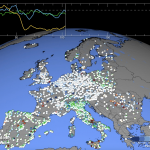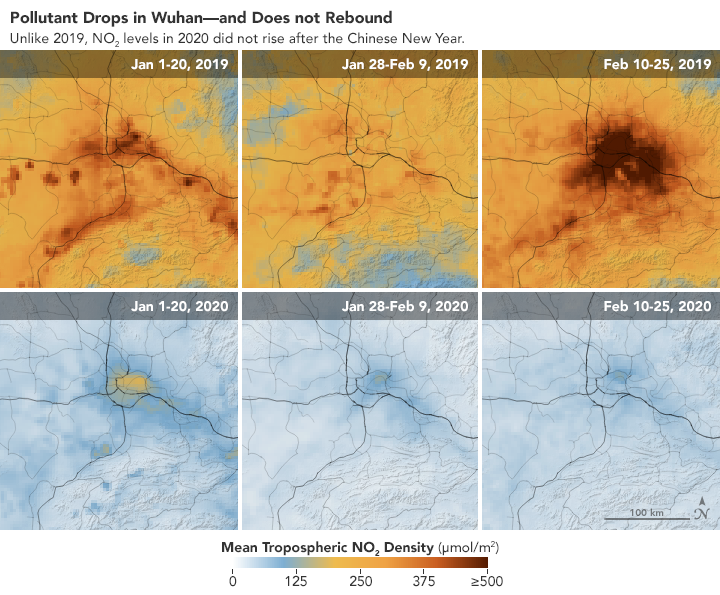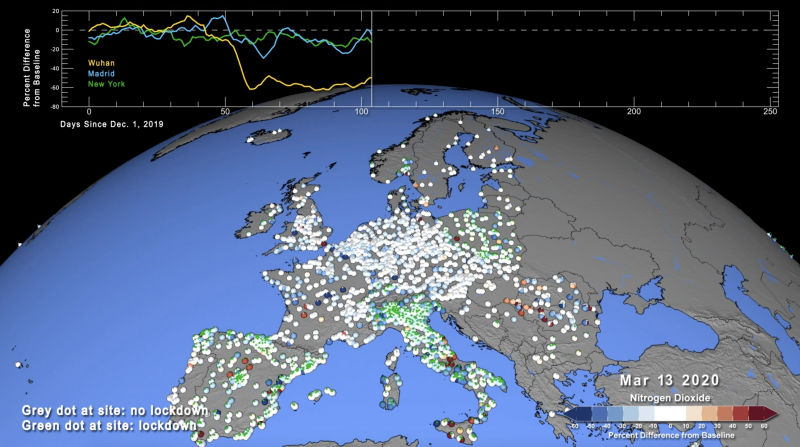
Since the Covid-19 pandemic began, both satellite and ground-based observations have shown significant reductions in some air pollutants. In a new study that used computer models to generate a Covid-free 2020 for comparison, a team of NASA scientists looked at how much of that decline can be attributed to changes in human activity during pandemic-related shutdowns, versus how much would have occurred in a pandemic-free 2020.
The researchers studied global emissions of the air pollutant nitrogen dioxide, which is primarily produced by the combustion of fossil fuels in industry and transportation, both of which were significantly reduced during pandemic restrictions and shutdowns. The scientists found that since February 2020, pandemic restrictions have reduced global nitrogen dioxide concentrations by nearly 20%.
The results were presented at the 2020 International Conference for High Performance Computing, Networking, Storage, and Analysis, held virtually November 16-19.
Christoph Keller of NASA’s Goddard Space Flight Center is lead author of the study. Keller said in a statement:
In some ways I was surprised by how much it dropped. Many countries have already done a very good job in lowering their nitrogen dioxide concentrations over the last decades due to clean air regulations, but what our results clearly show is that there is still a significant human behavior-driven contribution.

Nitrogen dioxide levels often dip during Lunar New Year celebrations in China and much of Asia, and then rebound. But no rebound was evident this year over Wuhan, China, where the virus was first reported, and nitrogen dioxide levels remained much lower than in 2019. Image via NASA.
Normal variations in Earth’s weather and atmospheric circulation change the make-up and chemistry of the atmosphere, so no two years are exactly alike. Comparing 2020 nitrogen dioxide concentrations with data from 2019 or 2018 alone would not account for year-to-year differences. But, said the researchers, because the model projections account for these natural variations, scientists can use them to estimate how much of the 2020 atmospheric composition change was caused by the Covid-19 containment measures. Keller said:
We all knew the lockdowns were going to have an impact on air quality. It was also soon clear that it was going to be difficult to quantify how much of that change is related to the lockdown measures, versus general seasonality or variability in pollution.
But even with models, the researchers said, there was no predicting the sudden, drastic shifts in human behavior as the novel coronavirus – and the regulations attempting to control it – spread rapidly. Instead of trying to reprogram their model with this unexpected event, Keller and his colleagues accounted for Covid-19 by having the model ignore the pandemic altogether. Its “business as usual” scenario showed an alternate reality version of 2020, one that did not experience any unexpected changes in human behavior brought on by the pandemic.
From there, said the researchers, it was simple subtraction: The difference between the model’s simulated values and the actual measured observations represented the change in emissions due to the pandemic response.

The researchers received data from 46 countries — a total of 5,756 observation sites on the ground — relaying hourly atmospheric composition measurements in near-real time. On a city level, 50 of the 61 analyzed cities showed nitrogen dioxide reductions between 20 and 50%. Image via NASA.
According to the study, Wuhan, China, the first municipality reporting an outbreak of Covid-19, was also the first to show reduced nitrogen dioxide emissions, 60% lower than simulated values expected. A 60% decrease in Milan and a 45% decrease in New York followed shortly as their local restrictions went into effect. NASA Goddard’s Emma Knowland is a study co-author. She said:
You could, at times, even see the decrease in nitrogen dioxide before the official policies went into place. People were probably reducing their transit because the talk of the Covid-19 threat was already happening before we were actually told to shut down.
Once restrictions were eased, the decreases in nitrogen dioxide lessened, but remained below expected “business as usual” values.
Bottom line: Since the Covid-19 pandemic began, there have been significant reductions in some air pollutants. A new study, using computer models to generate a Covid-free 2020 for comparison, looked at how much of that decline can be attributed to changes in human activity during pandemic-related shutdowns, versus how much would have occurred in a pandemic-free 2020.
from EarthSky https://ift.tt/37DgKGf

Since the Covid-19 pandemic began, both satellite and ground-based observations have shown significant reductions in some air pollutants. In a new study that used computer models to generate a Covid-free 2020 for comparison, a team of NASA scientists looked at how much of that decline can be attributed to changes in human activity during pandemic-related shutdowns, versus how much would have occurred in a pandemic-free 2020.
The researchers studied global emissions of the air pollutant nitrogen dioxide, which is primarily produced by the combustion of fossil fuels in industry and transportation, both of which were significantly reduced during pandemic restrictions and shutdowns. The scientists found that since February 2020, pandemic restrictions have reduced global nitrogen dioxide concentrations by nearly 20%.
The results were presented at the 2020 International Conference for High Performance Computing, Networking, Storage, and Analysis, held virtually November 16-19.
Christoph Keller of NASA’s Goddard Space Flight Center is lead author of the study. Keller said in a statement:
In some ways I was surprised by how much it dropped. Many countries have already done a very good job in lowering their nitrogen dioxide concentrations over the last decades due to clean air regulations, but what our results clearly show is that there is still a significant human behavior-driven contribution.

Nitrogen dioxide levels often dip during Lunar New Year celebrations in China and much of Asia, and then rebound. But no rebound was evident this year over Wuhan, China, where the virus was first reported, and nitrogen dioxide levels remained much lower than in 2019. Image via NASA.
Normal variations in Earth’s weather and atmospheric circulation change the make-up and chemistry of the atmosphere, so no two years are exactly alike. Comparing 2020 nitrogen dioxide concentrations with data from 2019 or 2018 alone would not account for year-to-year differences. But, said the researchers, because the model projections account for these natural variations, scientists can use them to estimate how much of the 2020 atmospheric composition change was caused by the Covid-19 containment measures. Keller said:
We all knew the lockdowns were going to have an impact on air quality. It was also soon clear that it was going to be difficult to quantify how much of that change is related to the lockdown measures, versus general seasonality or variability in pollution.
But even with models, the researchers said, there was no predicting the sudden, drastic shifts in human behavior as the novel coronavirus – and the regulations attempting to control it – spread rapidly. Instead of trying to reprogram their model with this unexpected event, Keller and his colleagues accounted for Covid-19 by having the model ignore the pandemic altogether. Its “business as usual” scenario showed an alternate reality version of 2020, one that did not experience any unexpected changes in human behavior brought on by the pandemic.
From there, said the researchers, it was simple subtraction: The difference between the model’s simulated values and the actual measured observations represented the change in emissions due to the pandemic response.

The researchers received data from 46 countries — a total of 5,756 observation sites on the ground — relaying hourly atmospheric composition measurements in near-real time. On a city level, 50 of the 61 analyzed cities showed nitrogen dioxide reductions between 20 and 50%. Image via NASA.
According to the study, Wuhan, China, the first municipality reporting an outbreak of Covid-19, was also the first to show reduced nitrogen dioxide emissions, 60% lower than simulated values expected. A 60% decrease in Milan and a 45% decrease in New York followed shortly as their local restrictions went into effect. NASA Goddard’s Emma Knowland is a study co-author. She said:
You could, at times, even see the decrease in nitrogen dioxide before the official policies went into place. People were probably reducing their transit because the talk of the Covid-19 threat was already happening before we were actually told to shut down.
Once restrictions were eased, the decreases in nitrogen dioxide lessened, but remained below expected “business as usual” values.
Bottom line: Since the Covid-19 pandemic began, there have been significant reductions in some air pollutants. A new study, using computer models to generate a Covid-free 2020 for comparison, looked at how much of that decline can be attributed to changes in human activity during pandemic-related shutdowns, versus how much would have occurred in a pandemic-free 2020.
from EarthSky https://ift.tt/37DgKGf

Aucun commentaire:
Enregistrer un commentaire